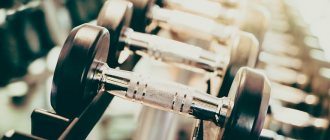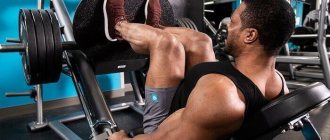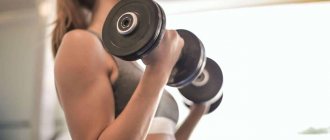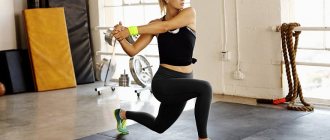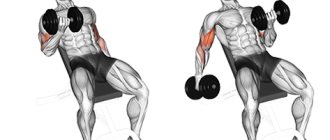Sculpted, strong muscles are not just beautiful. “Building muscle is a preventative measure with which you can avoid the diseases of civilization,” says Andreas Stippler, internist, rehabilitation specialist and author of the best-selling book “Muscles, How Are You?” . “It doesn’t matter whether it’s diabetes, obesity or worn-out joints with damaged discs: strong muscles save the day. I regularly use strength training in therapy. At first, patients are extremely skeptical, but later they are often surprised by its effect.”
How muscles grow
First, let’s explain: from a physiological point of view, muscles do not grow, but increase in volume. This is a complex process that is triggered by a hormonal response to physical activity. Testosterone and somatotropin, growth hormone, play a major role here.
During training, segments of muscle fibers are damaged, the process of restoration of these microtraumas looks like an increase in muscle volume. In order for it to proceed normally (that is, muscle volume constantly increases), several factors are important.
- Having regular strength training.
- Adequate protein intake.
- Increased calorie intake.
- Sufficient time for rest and recovery.
In other words, you won’t be able to pump up voluminous muscles just by “killing yourself” in the gym - the body simply won’t have the resources for this. “You need to remember that training stimulates muscle growth, and this process is based on proper nutrition,” says Valentin Zinin, instructor of SuperPopa group programs at Kometa fitness clubs.
You are not consuming enough protein
If you want to get more pumped up, you need to eat more protein. Reason: Protein contains amino acids, chemical compounds that help build and repair muscle tissue. If you don't consume enough amino acids, it can hinder your muscle growth.
Solution: Eat 1.2 to 1.7 grams of protein per kg of body weight each day. This means that a person weighing 200 pounds should get between 109 and 154 grams of protein per day. And remember that it comes from foods such as chicken, fish, red meat and eggs. Those. Only animal protein should be taken into account.
How quickly muscles grow after training
It is believed that the process of repairing damaged fibers begins approximately 2-3 hours after training. This process requires energy and “building material” (proteins), which is why it is recommended to close the “protein-carbohydrate window” after a weight training session. The optimal snack after a fitness lesson is cottage cheese with dried fruits, a turkey sandwich, protein bars, smoothies with cottage cheese and fruits.
The process of muscle recovery lasts approximately 36-48 hours (depending on the muscle group). At this time, it is important not to overload the muscles, sleep enough time, and eat right. The mass of fibers and their cross-sectional area gradually increases. As a result, each individual muscle adapts to the load and begins to work more efficiently - you become more resilient and can handle heavier weights.
How quickly muscles grow from training depends on many factors. “If you do everything correctly, then after about 6-8 weeks of regular exercise you can notice tangible progress,” says Valentin Zinin.
The rate of muscle growth is also affected by training experience. For beginners, in the first six months of training, muscles grow very quickly. “So, a beginner, with proper nutrition and a competent training program, can gain about 2-3 kg of muscle mass in 3-4 months, this is 1-1.5 cm in volume,” says Valentin Zinin.
Over time, the body adapts to the stress, and muscles grow more slowly. However, experts advise focusing not on muscle volume, but on their weight. This parameter can be measured using bioimpedancemetry, an assessment of the qualitative composition of the body. Under ideal conditions, a beginner can gain up to 12 kg of muscle mass per year; on the scales this will look like a “gain” of 15-20 kg. But you shouldn’t chase beautiful numbers - for some asthenic athletes, gaining even 8 kg of muscle per year will be a good result.
You avoid carbohydrates
Sources of fast carbohydrates (candy, pizza, white bread, etc.) should not appear in your diet, but it is important to remember that not all carbohydrates are the enemy. In fact, cutting your carb intake too sharply may be the very reason you're starting to look a little out of shape. When your diet is low in carbs, your muscles don't get the glycogen they need to build mass. This can affect muscle growth and make you feel weaker.
Solution: You need to introduce complex (slow) carbohydrates into your diet (oatmeal, buckwheat, brown rice, whole grain bread, beans, fruits, etc.) and limit the consumption of foods containing starch.
What workouts make muscles grow?
If you are new to a fitness club, you may be able to notice slight muscle growth from almost any workout - be it Pilates or step aerobics. “However, for a stable increase in muscle volume, adequate strength load is needed,” says Valentin Zinin. “That is, requiring approximately 80-90% of your maximum effort.”
The optimal duration of such a lesson is 60-90 minutes. Lighter workouts simply won’t start the process of muscle growth, while more intense workouts will slow it down.
“But muscles do not grow from cardio exercise, but, nevertheless, you should not exclude them from your schedule, they are important for the development of endurance,” adds Valentin Zinin.
You don't drink enough fluids
When building muscle is the goal, people usually focus on consuming carbohydrates and protein. But when it comes to consuming adequate amounts of water, many guys keep their muscles dehydrated. Water is crucial for digestion, so when there is not enough of it, it can negatively affect this process. As a result, your muscles will not receive the nutrients they need to grow. Plus, when you don't drink enough water, it's harder to give it your all in the gym, which can further impact your performance.
Solution: You should drink 1/30 of your weight in liters per day. (This means that a guy weighing 90 kg should drink 3 liters of water daily). “And if you're thirsty, you're dehydrated. Therefore, even if you have already reached your water allowance, drink.
Myth four. If you stop strength training, all your muscle will turn into fat.
Muscle and fat are two completely different types of tissue that,
by definition, cannot turn into each other True, people who quit training not only lose muscle mass, but often stop watching their diet. As a result, lack of physical activity and overeating lead to weight gain. It may seem like your muscles have turned into fat, but in fact your muscle mass has decreased and your fat mass has increased. There is also an opposite myth, common among female gym goers: “During training, fat turns into muscle.” The same mechanism works here. As a result of training, the body changes visually, because fat mass decreases and muscle mass increases.
Teenagers and weight training equipment
Alexey Korochkin, a researcher at the Department of Exercise Therapy and Sports Medicine at the Russian State Medical University, talks about how to properly start strength training in adolescence.
Myth two. Strength training reduces/increases breast size.
Unfortunately, or fortunately, this is not the case. The female breast - the mammary gland - consists mainly of adipose tissue. Therefore, it is impossible to “pump up” it. The only way to enlarge your breasts is to gain weight (that is, increase fat deposits throughout your body) or get implants. Breast size can decrease only when the percentage of fat mass in the body reaches a critically low level - about 12 percent. True, this is already a reason for hospitalization due to exhaustion - it has nothing to do with strength training.
Change your nutrition program
So, you have increased your working weights, adjusted your exercise technique, and finalized your training program. Your mass increases, which means your muscles need more building material to grow.
It's time to change your nutrition program.
Yuri Spasokukotsky recommends increasing caloric intake gradually. If you're just starting to overcome plateaus in muscle gain, your caloric intake should increase by about 1,000 kcal over the next five months.
Calorie content can be increased not only through complex carbohydrates. You can add glucose, fructose, sucrose, that is, simple carbohydrates, to your diet. The main thing is to make a proper meal schedule. If you eat simple carbohydrates in the morning and after training, then you don’t have to worry about excess fat, you won’t gain it, but your muscle mass will increase a little more
By following these simple recommendations from Yuri Spasokukotsky, you can easily overcome your training plateau and continue to build muscle mass! Remember: you will encounter more than one obstacle on your life and sports path.
You can admit defeat and turn back, but this is clearly not the philosophy of a winner. Do you want to be among the champions? Then don’t give up, try new solutions, move forward and then the result - an ideal and spectacular body - is guaranteed!
Recipes for gaining weight:
Pancakes with apple and cinnamon
There are days when you want to treat yourself to something delicious. A tasty and healthy dessert will perfectly complement a light dinner of vegetable dishes, the main thing is to know the measure and the recipe. Apple Cinnamon Pancakes contain 166 calories.
You can reduce their calorie content by adding less sugar and replacing regular flour with whole grain flour or ground oatmeal. And preparing such a dinner is easy and simple.
Pancakes with apple and cinnamon
Recipe No. 1
Cooking instructions:
- Mix flour, eggs, sugar, milk, baking powder and cinnamon. Beat the dough with a whisk or mixer until smooth. Make sure there are no lumps. Add some salt.
- Add vegetable oil to the dough and beat again.
- Wash the apples, remove the core and cut as thin as possible.
- Heat the frying pan. To avoid using oil for frying, cook in a non-stick pan. You need to fry pancakes over low heat.
- Once you have poured the batter, place the apple pieces on the pancake, pressing them lightly into the batter.
- When the pancake is fried on one side, carefully turn it over and press it down a little with a spatula so that the apples do not interfere with the dough's frying.
- Fry pancakes using all the dough in this way.
- The finished dish can be sprinkled with cinnamon or powdered sugar.
Ingredients: - 2 apples; - 300 g flour; - 1 egg; - 0.5 tsp cinnamon; - 200 ml milk; - 50 g sugar; - 1 tbsp. vegetable oil; - 0.5 tsp baking powder; - 2 pinches of salt.
Shoulder workout
Standing dumbbell lateral raises
- 4 sets of 12 reps
- Body part: Shoulders Equipment: Dumbbells
Bent-over dumbbell raises
- 3 sets of 8-10 reps
- Body part: Shoulders Equipment: Dumbbells
Two-hand dumbbell lateral raises
- 3 sets of 8-10 reps
- Body part: Shoulders Equipment: Dumbbells
Dumbbell flyes with rotation while lying on an incline bench
- 3 sets of 8-10 reps
- Body part: Shoulders Equipment: Dumbbells
Add to Calendar * Add to My Workouts * Print Workout
* — The service is in beta testing
Where does underweight come from?
This problem can have several different causes or a combination of them. Thus, underweight most often occurs when:
- insufficient nutrition, when its caloric content is lower than the basic needs of the body (small portions, only low-calorie foods, rare meals, for example, only 2 times a day);
- poor absorption of nutrients by the body (most often a consequence of certain metabolic problems and diseases);
- lack of healthy appetite (reduced reaction of the hunger center, lack of hormones responsible for the desire to eat, post-morbid or painful state);
- eating disorders (ED), for example, anorexia, orthorexia, selective disorders;
- hormonal disorders;
- long fasting and frequent fasting days;
- serious illnesses.
Before prescribing examinations and tests for a client, simply talk to him about his diet. Find out what he usually eats, at what time and how often. You can ask him to keep a diary of food and physical activity for a week to see the whole picture.
If a person complains of poor appetite, then try to understand what is causing it: deliberate dietary restriction or possible health problems. This is especially important for underweight children or adolescents, who often do not admit that they do not want to eat at all and can hide the real volumes of their diet.
In cases where the client is simply malnourished and provided that he does not have an eating disorder or other mental disorders, weight gain is most often achieved by simply creating a daily calorie surplus. This will work for people who do not have serious health conditions that caused them to be thin in the first place.
However, it is possible that you are dealing with vegans, raw foodists and other restrictive dieters, as well as with clients who have primary symptoms of eating disorders. Working with them will be long and multifaceted.
Vegetarians will have to develop a sufficiently high-calorie diet, taking into account their food preferences and principles, but the correction of eating disorder will largely take place in the plane of psychotherapy.
There is another interesting category of clients - professional athletes and dancers, for example, gymnasts, ballerinas, who are prohibited from gaining weight above a certain norm. Long-term strict dietary restrictions and grueling training lead to the fact that a person’s weight becomes noticeably below adequate levels.
It is also often necessary to involve psychologists in weight correction among athletes, since their eating behavior may be based on deliberate dietary restrictions. If you do not intervene in time, this position will eventually lead to the development of anorexia or bulimia.
Changing the diet
If you ask an experienced trainer how to gain weight at home, the answer will be the same - start eating right. We focus on increasing the number of incoming calories and balance. Everything is individual here - for some, a 15% increase in calories is enough, for others, others will have to increase the amount of calories by one and a half to two times.
Here are general tips for improving your nutrition system:
- Consume more protein foods. Focus on poultry, seafood, fish, and nuts. It is important that the food consumed contains as little saturated refractory (animal origin) and trans fats (fast food, baked goods - everything made with margarine) as possible. But there should be more unsaturated fats. To do this, include olive, rapeseed, and peanut oil in your diet.
- A good choice would be legumes - beans, chickpeas. Lentils suit many people. But we don’t recommend relying on soy, especially for women. Boiled eggs also help with weight gain—pros eat at least six of them a day.
- Don't forget complex carbohydrates. Various porridges are perfect for lean meat - from rice and buckwheat to corn and pearl barley. Add black bread, pasta, vegetables (preferably without starch) to your diet. Athletes also need fruits, but only if they are low in sugar.
- Always watch your calories. It is better to keep a table in which you write down how much you consume and spend every day.
- Set up a weight control routine. Every five days you need to step on the scale and mark the values. If muscle mass increases by less than 700 grams, more calories are needed. If it is significantly more than 700 grams, the calorie content should be reduced.
An important aspect in gaining weight is the frequency of nutrition. We recommend splitting your meals into five to six times, that is, eating in smaller portions, but more often.
